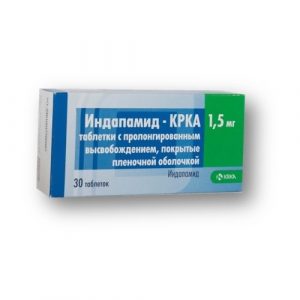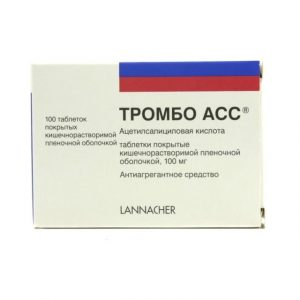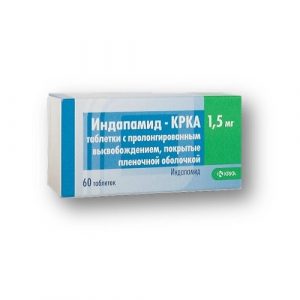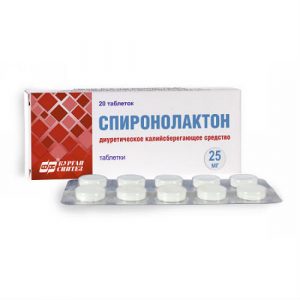Description
Release form
Tablets
Packaging
60 pcs
Pharmacological action of
Bisoprolol – selective beta1-blocker without its own sympathomimetic activity has antihypertensive, antiarrhythmic and antianginal action. Blocking beta1-adrenergic receptors of the heart in low doses, it reduces the formation of cyclic adenosine monophosphate (cAMP) stimulated by catecholamines from adenosine triphosphate (ATP), reduces the intracellular flow of calcium ions (Ca2 +), has a negative chrono-, dromo-, batmo- and inotropic effect (reduces the frequency contractions, inhibits conduction and excitability, reduces myocardial contractility).
With increasing doses has a beta2-blocking effect.
The total peripheral vascular resistance at the beginning of the use of beta-blockers, in the first 24 hours, increases (as a result of a reciprocal increase in the activity of alpha-adrenergic receptors and the elimination of stimulation of beta2-adrenergic receptors), which after 1-3 days returns to the original, and with prolonged use is reduced.
The antihypertensive effect is associated with a decrease in minute blood volume, sympathetic stimulation of peripheral vessels, a decrease in the activity of the renin-angiotensin-aldosterone system (more important for patients with initial hypersecretion of the renin), restoration of the sensitivity of the aortic arch baroreceptors (there is no increase in their activity in response to a decrease blood pressure (BP)) and effects on the central nervous system. With arterial hypertension, the effect occurs after 2-5 days, a stable effect – after 1-2 months.
The antianginal effect is due to a decrease in myocardial oxygen demand as a result of a decrease in heart rate and contractility, lengthening of diastole, and improvement of myocardial perfusion. By increasing the final diastolic pressure in the left ventricle and increasing the stretching of the muscle fibers of the ventricles, it can increase the myocardial oxygen demand, especially in patients with chronic heart failure (CHF).
Unlike non-selective beta-blockers, when administered at moderate therapeutic doses, it has a less pronounced effect on organs containing beta2-adrenergic receptors (pancreas, skeletal muscle, smooth muscles of the peripheral arteries, bronchi and uterus) and on carbohydrate metabolism, does not cause ion delay sodium (Na +) in the body. When used in large doses, it has a blocking effect on both subtypes of beta-adrenergic receptors.
Pharmacokinetics.
Bisoprolol is almost completely absorbed from the gastrointestinal tract (80-90%). Eating does not affect the absorption of the drug. The maximum concentration in blood plasma is reached after 2-3 hours. Communication with plasma proteins is approximately 35%. Permeability through the blood-brain barrier and the placental barrier is low, secretion with breast milk is low.
Metabolized in the liver. The half-life (T1 / 2) is 9-12 hours, lengthens with impaired renal function (with creatinine clearance less than
40 ml / min – 3 times), in old age, with liver diseases (with cirrhosis increases to 21.7 hours) . It is excreted by the kidneys – 50% unchanged, less than 2% through the intestine.
Contraindications
acute heart failure, chronic heart failure
decompensated,
cardiogenic shock,
collapse,
AV-block II and III degree (without pacemaker)
SSSL
sinoatrial blockade,
severe bradycardia (heart rate
Prinzmetal angina,
marked decrease in blood pressure (systolic blood pressure
severe forms of bronchial asthma and COPD with recent history of heart disease, acute rheumatoid arthritis, -adrenoblockers),
metabolic acidosis,
concomitant use of MAO inhibitors (except for type B MAO inhibitors),
children and adolescents under 18 years of age,
hypersensitivity to isoprolol and other beta-blockers.
Special instructions
From the nervous system: weakness, fatigue, dizziness, headache, sleep disorders, mental disorders (depression, rarely hallucinations), a feeling of cold and paresthesia in the limbs.
From the cardiovascular system: orthostatic hypotension, bradycardia, impaired AV conduction, the appearance of symptoms of heart failure, worsening intermittent claudication and the main clinical symptoms in Raynaud’s syndrome.
From the side of the organ of vision: decreased secretion of lacrimal fluid, conjunctivitis.
From the digestive system: diarrhea, constipation, nausea, abdominal pain.
From the musculoskeletal system: muscle weakness, muscle cramps.
From the skin and subcutaneous tissues: skin itching in some cases – increased manifestations of psoriasis, the appearance of psoriasis-like rashes.
From the respiratory system: in predisposed patients, symptoms of bronchial obstruction may occur.
Other: sweating, flushing, impaired potency, decreased glucose tolerance in patients with diabetes mellitus, allergic reactions.
Composition
1 tablet contains:
Active ingredient:
bisoprolol fumarate 5 mg.
Excipients:
lactose monohydrate,
microcrystalline cellulose,
silicon dioxide colloidal,
crospovidone,
magnesium stearate.
Dosage and administration
Inside, in the morning on an empty stomach, without chewing, 5 mg once.
If necessary, increase the dose to 10 mg once a day. The maximum daily dose is 20 mg / day.
In patients with impaired renal function with creatine clearance less than 20 ml / min or with severe impaired liver function, the maximum daily dose is 10 mg.
Dose adjustment in elderly patients is not required
Side effects
From the nervous system: weakness, fatigue, dizziness, headache, sleep disorders, mental disorders (depression, rarely hallucinations), a feeling of cold and paresthesia in the limbs.
From the cardiovascular system: orthostatic hypotension, bradycardia, impaired AV conduction, the appearance of symptoms of heart failure, worsening intermittent claudication and the main clinical symptoms in Raynaud’s syndrome.
From the side of the organ of vision: decreased secretion of lacrimal fluid, conjunctivitis.
From the digestive system: diarrhea, constipation, nausea, abdominal pain.
From the musculoskeletal system: muscle weakness, muscle cramps.
From the skin and subcutaneous tissues: skin itching in some cases – increased manifestations of psoriasis, the appearance of psoriasis-like rashes.
From the respiratory system: in predisposed patients, symptoms of bronchial obstruction may occur.
Other: sweating, flushing, impaired potency, decreased glucose tolerance in patients with diabetes mellitus, allergic reactions.
Drug interaction
With the simultaneous use of antacids and antidiarrheal drugs, it is possible to reduce the absorption of beta-blockers.
With the simultaneous use of antiarrhythmic drugs, a sharp decrease in blood pressure, a decrease in heart rate, the development of arrhythmia and / or heart failure are possible.
With the simultaneous use of antihypertensive drugs, it is possible to increase the antihypertensive effect.
Concomitant conduction disturbances with the simultaneous use of cardiac glycosides.
With the simultaneous use of sympathomimetics (including those included in cough, nose drops, and eye drops), the effectiveness of bisoprolol decreases.
With the simultaneous use of verapamil, diltiazem, a sharp decrease in blood pressure, a decrease in heart rate, the development of arrhythmia and / or heart failure are possible.
With the simultaneous use of guanfacine, severe bradycardia and conduction disturbances are possible.
With the simultaneous use of insulin, diltiazem possibly a sharp decrease in blood pressure, a decrease in heart rate, the development of arrhythmia and / or heart failure.
With the simultaneous use of guanfacine, severe bradycardia and conduction disturbances are possible.
With the simultaneous use of insulin, diltiazem possibly a sharp decrease in blood pressure, a decrease in heart rate, the development of arrhythmia and / or heart failure.
With the simultaneous use of guanfacine, severe bradycardia and conduction disturbances are possible.
With the simultaneous use of insulin,hypoglycemic agents for oral administration, the action of insulin or other hypoglycemic agents is enhanced (regular monitoring of plasma glucose levels is necessary).
With the simultaneous use of clonidine, severe bradycardia, arterial hypotension, and conduction disturbances are possible.
In the case of sudden withdrawal of clonidine in patients receiving bisoprolol, a sharp increase in blood pressure is possible.
With the simultaneous use of nifedipine, other calcium channel blockers, dihydropyridine derivatives, the antihypertensive effect of bisoprolol is enhanced.
With the simultaneous use of reserpine, alpha-methyldopa, severe bradycardia is possible.
With the simultaneous use of rifampicin, a slight decrease in T1 / 2 of bisoprolol is possible.
With the simultaneous use of ergotamine derivatives (including drugs for the treatment of migraine containing ergotamine) the symptoms of peripheral circulatory disorders are amplified.
Storage conditions
Store in a dry, dark place out of the reach of children, at temperatures not exceeding 20 ° C.
Active ingredient
Bisoprolol
Terms leave through pharmacies
In retseptu
lekarstvennaja form
tablets
Prescribing
For adults as prescribed by a doctor
Indications
Indications
arrhythmia, heart failure, hypertension
Vertex, Russia




